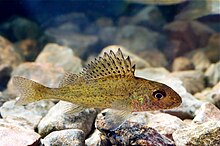Ruffe
| Eurasian ruffe | |
|---|---|
 |
|
| Ruffe in Pärnu River (Estonia) | |
| Scientific classification | |
| Kingdom: | Animalia |
| Phylum: | Chordata |
| Class: | Actinopterygii |
| Order: | Perciformes |
| Family: | Percidae |
| Genus: | Gymnocephalus |
| Species: | G. cernua |
| Binomial name | |
|
Gymnocephalus cernua (Linnaeus, 1758) |
|
| Synonyms | |
|
|
The Eurasian ruffe (Gymnocephalus cernua), also known as ruffe or pope, is a freshwater fish found in temperate regions of Europe and northern Asia. It has been introduced into the Great Lakes of North America, reportedly with unfortunate results, as it is invasive and is reproducing faster than other species. Its common names are ambiguous – "ruffe" may refer to any local member of its genus Gymnocephalus, which as a whole is native to Eurasia.
The ruffe's colors and markings are similar to those of the walleye, an olive-brown to golden-brown color on its back, paler on the sides with yellowish white undersides. The ruffe can reach up to 25 cm (9.8 in) in length, but is usually around half that size. It is a very aggressive fish for its size. The ruffe also has a large, spiny dorsal fin likely distasteful to its predators. It also has two fins on top, the front fin has hard and sharp spines, the back fin has soft spines called rays. The most obvious features to recognize a ruffe are the ruffe's large, continuous dorsal fin and its slightly downturned mouth.
In Eurasia, the ruffe diet mainly consists of zoobenthos: chironomids, small aquatic bugs and larvae, which are all found in the benthic zone of the water column. As far as researchers have been able to learn, it has kept the same diet in its transfer to the Great Lakes.
The ruffe has the capacity to reproduce at an extremely high rate. A ruffe usually matures in two to three years, but a ruffe that lives in warmer waters has the ability to reproduce in the first year of life. A single female has the potential to lay from 130,000 to 200,000 eggs annually. Ruffe will leave the deep dark water where they prefer and journey to warmer shallow water for spawning. The primary spawning season for the ruffe occurs from the middle of April through approximately June.
...
Wikipedia

